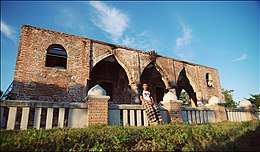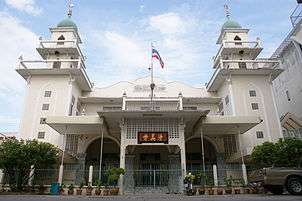Krue Se Mosque
Krue Se Mosque (Malay: Masjid Kerisek; Thai: มัสยิดกรือเซะ; RTGS: matsayit krue-se) also called Gresik Mosque, Pitu Krue-ban Mosque (Thai: มัสยิดปิตูกรือบัน) or Sultan Muzaffar Shah Mosque, is a mosque in Pattani Province, Thailand. Its construction may have begun in the 16th century. The current structure features a mixture of Middle Eastern and European architectural styles.[1]
| Krue Se Mosque | |
|---|---|
 | |
| Religion | |
| Affiliation | Islam |
| Location | |
| Location | Pattani, Thailand |
| Architecture | |
| Type | Mosque |
History
It is unclear when the mosque was first constructed. According to Hikayat Patani, a history of the Pattani Kingdom, two mosques were constructed during the reign of Sultan Muzaffar Shah (d.1564), one of which was built at the town square (padang) and may be this mosque.[2] It is also said that it was built during the reign of the Ayutthaya king Naresuan the Great.[3] A mosque was known to be have been constructed by the early 17th century; Jacob van Neck wrote in a Dutch report in 1603 that the then principal mosque of Patani "was very neatly constructed by Chinese workers from red bricks".[4] A later 17th century account by Dutch traveler Johan Nieuhof says of the mosque in Patani:
The Mohametan church is a stately edifice of red brickwork, gilt very richly within, and adorned with pillars, curiously wrought with figures. In the midst close to the wall is the pulpit, carv'd and gilt all over, unto which the priests are only permitted to ascend by four large steps.[5]
Some local Patani people believe that the mosque was built by the Chinese pirate Lin Daoqian (Lim Toh Khiam), who according to local lore married the daughter of the Sultan of Patani and converted to Islam.[4] Next to the mosque is a garden as well as the gravestone of Lin Guniang (Lim Ko Niao), said to be the sister of Lin Daoqian, who in this tale placed a curse so the dome of the mosque could not be completed.[6][7]
The mosque was designated a historical site by the Department of Fine Arts of Thailand in 1935. Restoration works on its structure were done in 1957 and 1982.[8] Further renovation was completed in 2005.[9]
Krue Se Mosque incident
On 28 April 2004, during Thaksin Shinawatra's premiership and in a period of insurgency by Islamic nationalists in the southernmost provinces, 32 gunmen took shelter in the mosque, after more than 100 militants carried out attacks on 10 police outposts across Pattani, Yala, and Songkhla Provinces.[10] After a seven-hour stand-off with Thai military personnel, soldiers attacked and killed all 32.[11] The attack contravened orders from the Minister of Defence to end the confrontation peacefully, and has been the subject of an international inquiry, which concluded the military used excessive force.
References
- "มัสยิดกรือเซะ". Pattani Province. Archived from the original on 29 June 2006.
- Bougas, Wayne (1990). "Patani in the Beginning of the XVII Century". Archipel. 39: 113–138.
- Alan Teh Leam Seng (1 June 2019). "Mystery of the unfinished mosque". New Straits Times.
- Reid, Anthony (30 August 2013). Patrick Jory (ed.). Ghosts of the Past in Southern Thailand: Essays on the History and Historiography of Patani. NUS Press. pp. 12–13, 22–23. ISBN 9789971696351.
- Sheehan, J. J. "Seventeenth Century Visitors to the Malay Peninsula". JMBRAS. 12 (2): 94–107. JSTOR 41559513.
- Francis R. Bradley (2008). "Piracy, Smuggling, and Trade in the Rise of Patani, 1490–1600" (PDF). Journal of the Siam Society. 96: 27–50.
- "แหล่งโบราณคดีภาคใต้ - มัสยิดกรือเซะ". คลังเอกสารสาธารณะ. 19 May 2009.
- "All points lead to Pattani". The Nation Thailand. 5 July 2019.
- "บูรณะ" มัสยิดกรือเซะ" เสร็จเรียบร้อย". ประชาไท. 4 February 2005.
- "Shattered by horrific events". The Nation. 29 April 2006. Archived from the original on 19 January 2012. Retrieved 3 November 2011.
- "Thai mosque killings criticised". BBC News. 28 July 2004.
| Wikimedia Commons has media related to Krue Se Mosque, Pattani. |

